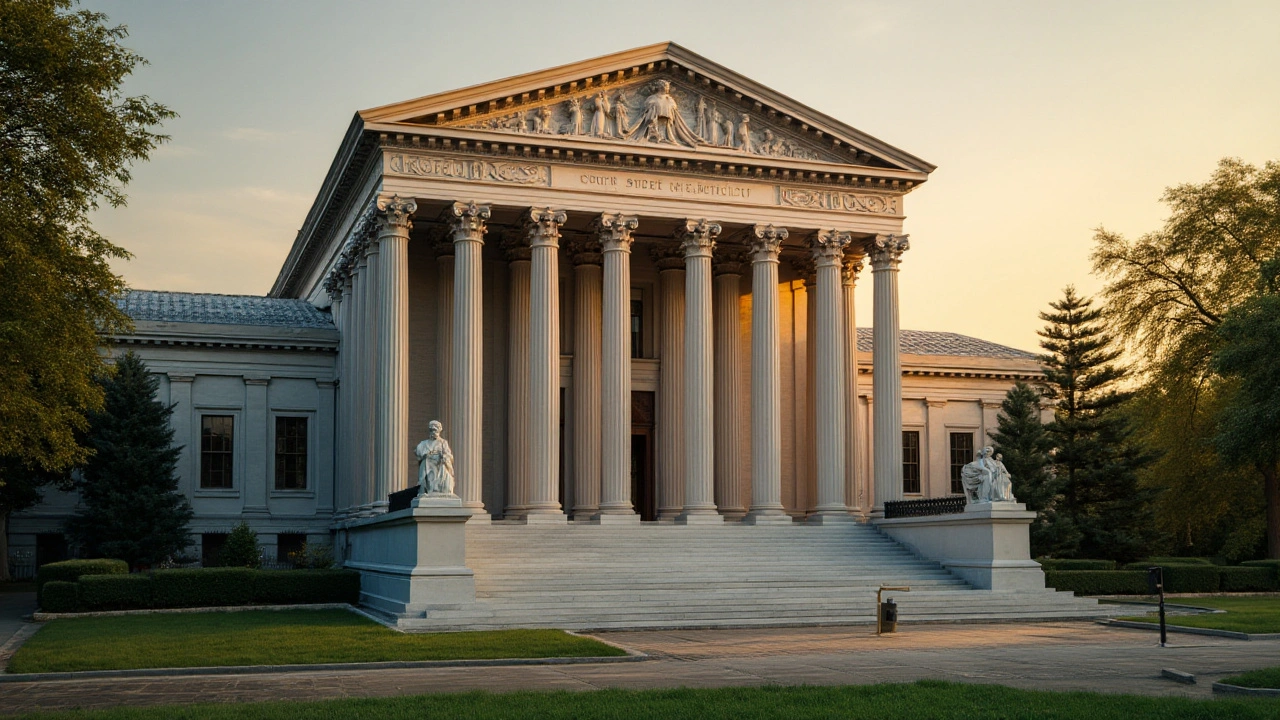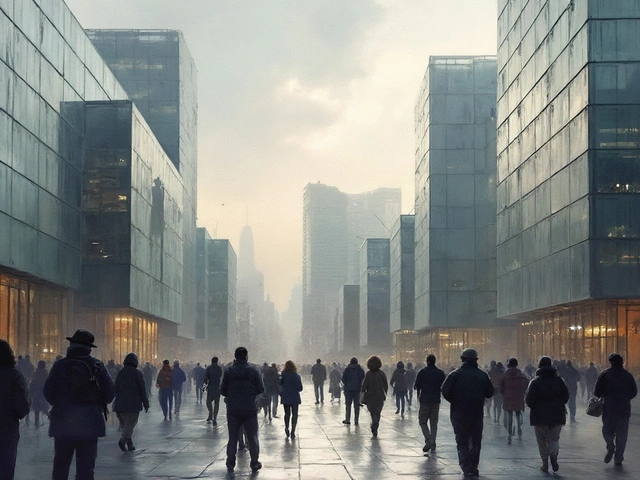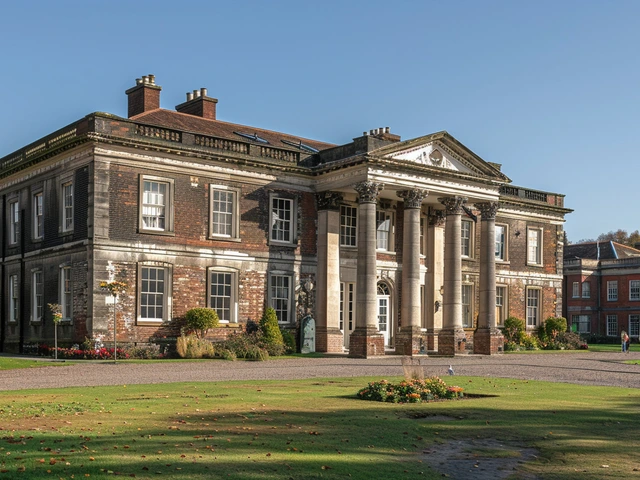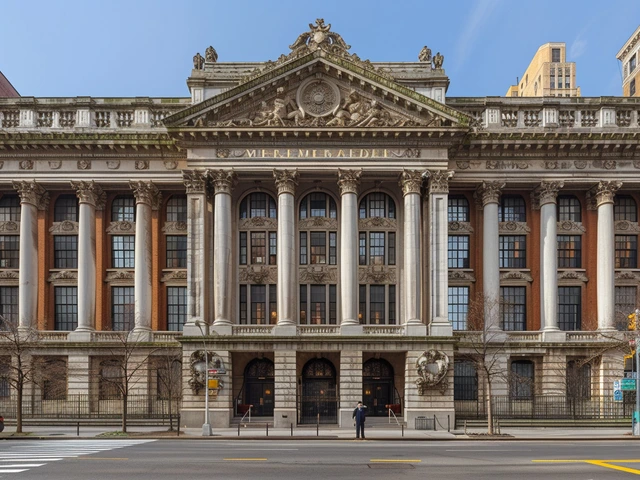When stepping back into the late 1700s and early 1800s, one can begin to appreciate the strong lines and powerful presence of federal architecture. This architectural style rose to prominence in the post-colonial era of the United States, channeling a nation's ambition and burgeoning self-identity into stone, brick, and mortar.
Influenced by classical antiquity, federal architecture reflects ideals of balance and symmetry, much like the democratic principles of the new republic. As you explore structures across the country, from quaint towns to the vibrant capital, the spirit of early America whispers through the columns and cornices. Learning about these buildings not only helps us trace architectural evolution but also uncovers layers of the American historical landscape.
Origins and Influences
The roots of federal architecture trace back to a period when the United States was steering away from its colonial past and crafting a new identity. This style, emerging in the late 18th century, came into prominence during the post-independence era between 1780 and 1830. Bridging the transition from the decorative colonial Georgian style to a more austere and democratic architectural expression, federal architecture was deeply inspired by the Roman and Greek classics, which were synonymous with the ideals of democracy and order. The admiration for Roman republican virtues was no accident; it was intentional, reflecting a desire to parallel America's nascent democratic government with the ancient, revered political systems of the past.
American architects of this era, such as Benjamin Latrobe and Charles Bulfinch, were influenced heavily by the work of Andrea Palladio, an Italian architect of the Renaissance whose designs extolled symmetry, perspective, and the use of classical Roman temple fronts. His work inspired the construction of many structures that maintained geometric harmony in their design, a key characteristic of federal architecture. This architectural movement was not just about aesthetics; it was a statement—a reflection of national aspirations. Thomas Jefferson—an enthusiast of classical antiquity—advocated fervently for this style, believing it symbolized democratic purity and virtue. He declared, "Architecture is the triumph of human imagination, and a building should please for the moment and form a memorable point in human experience."
The influences leading to the development of federal architecture were multifaceted. British architect Robert Adam, whose works in the neoclassical style reshaped the landscape of contemporary architecture, left a significant mark. His influence filtered across the Atlantic, infusing the American architectural scene with a taste for Roman decorative motifs such as garlands and urns, along with innovative uses of stucco and woodwork. This synthesis of Adam’s refined designs and the American necessity for practicality birthed a new identity. The leaders of the American Enlightenment—a philosophical movement that emphasized reason and individualism—favored federal architecture because it captured the spirit of rationality and progressivism.
As patriotism soared following independence, there was a concerted effort to construct buildings that not only reflected the new nation's confidence but would stand the test of time as proud symbols of the American spirit. In communities large and small, you could find numerous public buildings—courthouses, college campuses, and homes of the affluent—showing signature elements such as a central dome, elaborate doorways, and fan-shaped windows. Although federal architecture is closely related back to a specific historic period, its influences are far-reaching. Its legacy is noted for fostering a national architectural identity that intertwined art and societal values. Today, these buildings serve as cultural touchstones, drawing us back to the era of founding forefathers and early patriots.
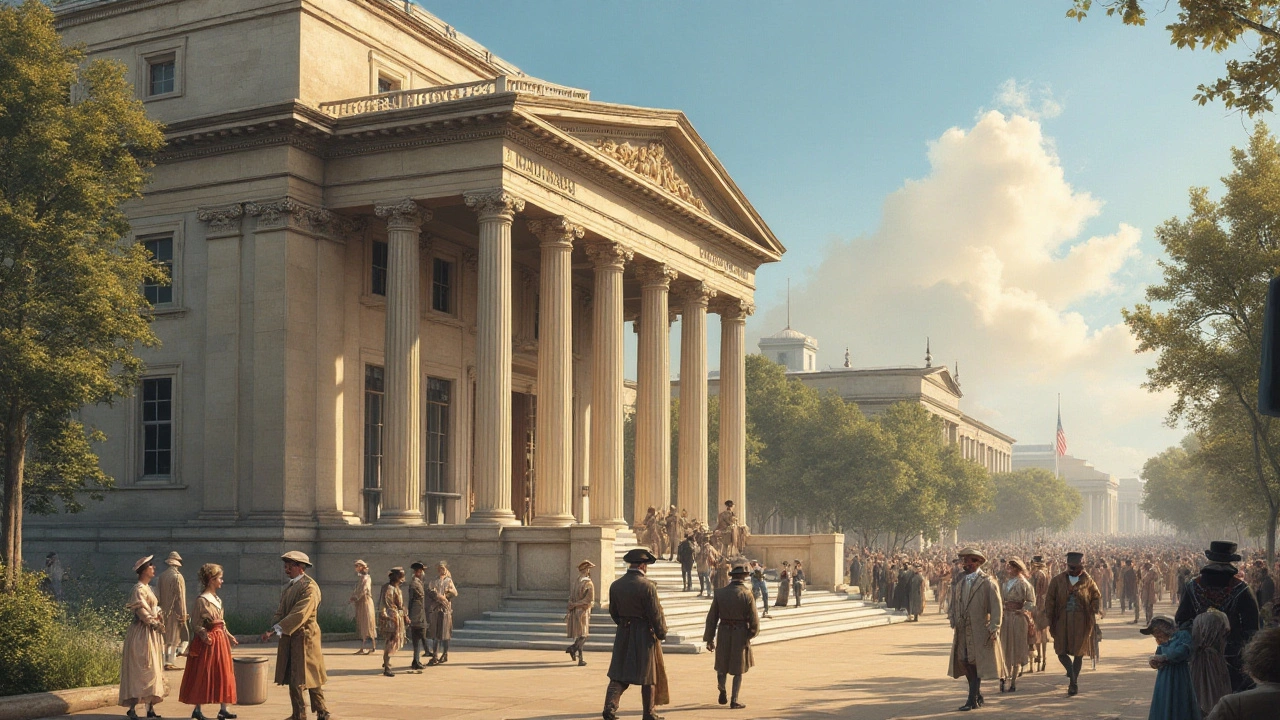
Key Features and Design
Federal architecture, with its austere symmetry and restrained ornamentation, stands as a testament to the young republic's aspirations. Emerging at the end of the American Revolution, this architectural style took heavy inspiration from Roman and Greek antiquities. One of the standout features is its emphasis on geometric simplicity, which resonates with the ideals of democracy and order that the new nation embraced. A hallmark of federal architecture is the use of elegant columns and porticoes that quietly whisper of ancient empires while grounding the buildings in modern, at the time, sensibilities.
Beyond the columns, the typical façade of a federal structure often includes a balanced arrangement of windows and doors, creating a visually pleasing rhythm that is both dignified and welcoming. These buildings frequently feature a central doorway adorned with a fanlight, an elliptical or semi-circular window, adding a touch of sophistication to the entrance. Such features are not merely for decoration but serve to invite sunlight into otherwise dim hallways, making them functional as well as beautiful. It's these subtle details that speak volumes about the priorities of early American society, emphasizing practicality infused with style.
Roaming around these historical buildings, one might also notice the intricate cornices and understated friezes that add layers of interest without overwhelming the eye. Unlike its predecessor, the ornate Georgian style, federal architecture leans towards a more muted palette, often using native materials like brick and stone, which were abundant and readily available. This not only underscored the importance of using local resources but also served to root these grand structures within the American landscape. The use of such materials speaks to the value placed on resilience and permanence in an era of burgeoning independence.
Federal designers placed great emphasis on the symmetry and balance derived from Palladian principles, which is evident in their roof designs. A low-pitched roof or a flat roofline is common, often with a simple decorative balustrade adding an extra element of order without dominating the structure. Simplicity reigned supreme in their ideals, as is evident in the lack of excessive embellishments. The respect for classical proportions and clarity of form shines through in the purity of these designs, establishing a foundation for future American architectural endeavors.
In one of his letters, Thomas Jefferson once remarked, "Architecture is my delight." His renovation of Monticello is a prime example of how federal architecture celebrated a harmonious blend of form and function. The style also heavily influenced public buildings, aligning with Jefferson's vision of a unified American identity through shared architectural ideals. These buildings are more than just remnants from the past; they are engraved with stories of ambition, unity, and the careful construction of a nation's character.
To understand the evolution and significance of federal architecture, one can also examine the ways it was shaped by contemporary economic and cultural factors. The style's promotion of order and simplicity reflected societal expectations during a time when America was discovering its voice on the world stage. Many federal buildings successfully embody the spirit of their age while still catering to modern needs. Even today, these structures adapt to new uses, showing the timelessness of the design choices made over two centuries ago. The stories captured within these walls continue to resonate, highlighting both the pragmatic and aspirational efforts of America's forefathers in the art of building their vision into reality.

Notable Federal Buildings
The United States is a treasure trove of federal architecture, showcasing both its democratic aspirations and architectural heritage. One iconic example is the White House, a symbol of the presidency, which was designed by James Hoban and completed in 1800. With its stately columns and classic symmetry, it stands as a testament to the country's early architectural ambitions, drawing inspiration from Roman classicism. In similar fashion, the U.S. Capitol, designed initially by William Thornton, represents another pinnacle of federal architectural style. Its imposing dome and grand neoclassical elements speak volumes about America’s self-image and the powerful message of unity and government authority it conveys.
As you venture beyond Washington D.C., the influence of this architectural style is evident in buildings such as the Massachusetts State House in Boston. Designed by Charles Bulfinch, an important figure in American architecture, this building blends elegant design with functional space. Its golden dome and graceful lines clearly reflect federal influences, making it a cornerstone of Boston's historical landscape. Another remarkable example is the Baltimore Basilica, also known as the Basilica of the National Shrine of the Assumption of the Blessed Virgin Mary. As one of the first Roman Catholic cathedrals constructed in the United States, Benjamin Henry Latrobe’s design demonstrates a blend of religious and federal architectural elements that has captivated visitors for generations.
While many of these structures were built in the late 18th and early 19th centuries, they remain relevant today, not just for their beauty but for the stories they continue to tell. For instance, a visit to the Virginia State Capitol, designed by Thomas Jefferson, immerses visitors in a rich narrative of the early American republic. Jefferson’s use of classical architecture signified a connection to ancient democracies and embodied Enlightenment ideals.
“Architecture, in the history of the world, is perhaps the single most important element in the civilizing of man,” said Henry-Russell Hitchcock, reinforcing the significance of federal architecture in shaping national identity.
Moreover, some buildings serve as important cultural touchstones, like the Charleston City Hall in South Carolina. Its federal architecture façade merges historical significance with civic pride and community identity. The building's design is often celebrated for its brick construction and elegant proportions, a delightful representation of the style that endures in public memory. These federal buildings are more than just physical structures; they are the silent storytellers of American ideals, aspirations, and the enduring spirit of innovation.
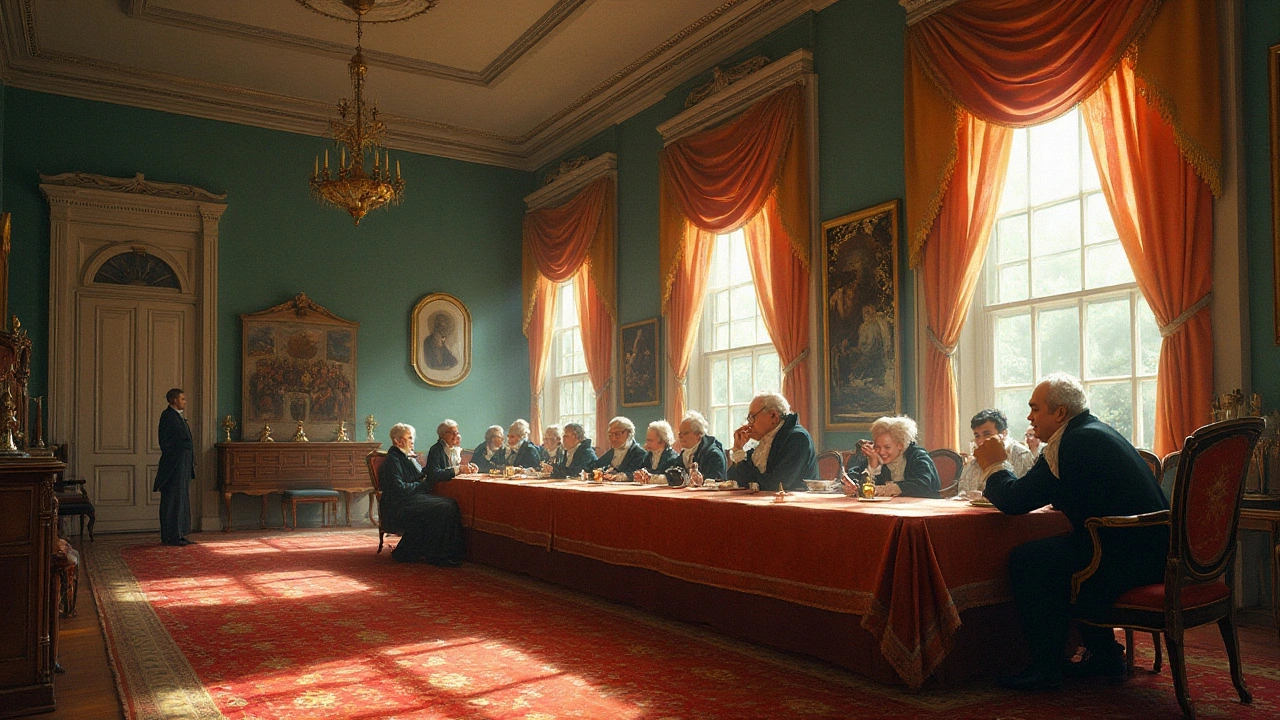
Federal Architecture Today
In modern times, the echoes of early federal architecture still resonate within the United States, though with a contemporary twist that blends the classical elegance with today's sensibilities. This architectural style, grounded in the principles of balance and proportion, has proven to be timeless in its appeal. Its lasting legacy can be seen in both preservation efforts and new constructions that draw inspiration from its classic lines.
Today's designers often pay homage to the history of federal architecture by incorporating its characteristic elements into public and private structures. This has resulted in a unique fusion that honors the past while creating something new and relevant. Courthouses and government buildings remain the most visible bastions of this style, but residential spaces also embrace its ideals. As cities grow and landscapes evolve, the preservation of historic federal buildings becomes a focal point of urban planning, attracting both national and global attention for their cultural significance.
"Federal architecture connects us to a history of democratic ideals and classical influence," says architectural historian Jane Smith. "Its endurance in the American landscape speaks volumes about our interconnectedness with the past."
These structures not only tell tales of the past but are also central to current discussions on urban development and cultural identity. Continual restoration efforts ensure that these buildings, often deemed living museums, remain integral to American heritage. Such projects highlight the commitment to maintaining the architectural integrity of these icons, often employing traditional methods to preserve their authenticity.
Newer buildings often incorporate the classical details of federal design in innovative ways, reflecting a respect for tradition while meeting contemporary needs. The use of modern materials and technologies allows for creative adaptations that preserve the essence yet ensure functionality. Key elements, such as the iconic columns and symmetrical facades, are reimagined using sustainable practices, making them exemplary models of eco-friendly architecture.
The appreciation for federal architecture goes beyond mere aesthetics; it's about understanding a period of transformation in American history. This style continues to serve as a reminder of the nation’s aspirations and the enduring influence of its foundational principles. As we move forward, the challenge remains to maintain the delicate balance between preservation and progression, ensuring that this architectural legacy keeps inspiring future generations.

